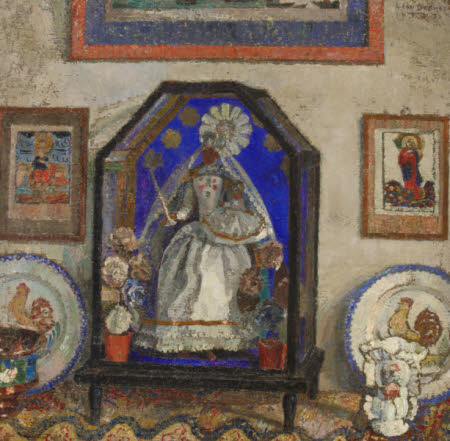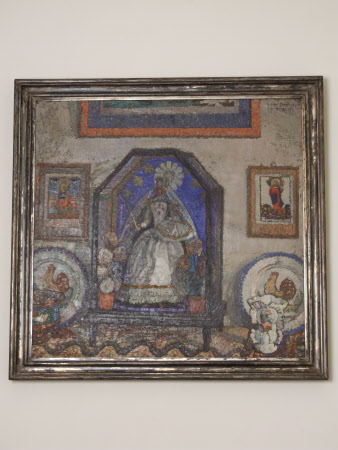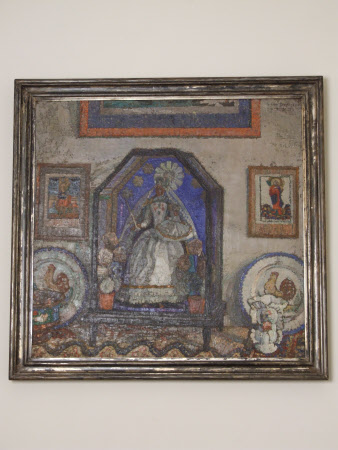Still Life with an Image of the Madonna in a Glass Case
Léon de Smet (Ghent 1881 – Deurle 1966)
Category
Art / Oil paintings
Date
1923
Materials
Oil on canvas
Order this imageCollection
Shaw's Corner, Hertfordshire
NT 1275305
Summary
Oil painting on canvas, "Still Life with an Image of the Madonna in a Glass Case", by Léon de Smet (Ghent 1881 – Deurle 1966). 1923. Depicts part of a sideboard in a domestic interior (the artist's own residence). On the sideboard sitting on a cloth stands a glass case with black frame and four baluster feet, containing the Virgin and Child dressed in white, against a lapis lazuli sky with six stars. To right is a plate with a picture of a cockerel, and a white vase; to the left a similar plate and a circular stemmed dish. On the wall at the right is a picture of Christ and on the left a picture of a winged figure. At the top can be seen the bottom edge of a large painting. .
Full description
Léon De Smet was a Belgian refugee who came to London during the First World War and became acquainted with Bernard Shaw through his friends the writer John Galsworthy, and the wealthy arts patron Madame Lalla Vandervelde (the wife of the Belgian Socialist leader) who appeared in Shaw’s playlet Augustus Does His Bit. Over the years the Shaws purchased many of his oil paintings, and his crayon portrait of Shaw survives in the collection (NT 1274653). Bernard Shaw’s painting “Still Life with an Image of the Madonna in a Glass Case” (1923) by the Flemish artist Léon De Smet (1881-1966) depicts miniature devotional statuary on a sideboard in a domestic interior, functioning as a kind of shrine for worship within the home. A wax doll dressed in white and a child are surrounded by artificial flowers and suspended in a glass case, which sits on the sideboard alongside faience plates and prints of Christ. This type of figure was a popular Catholic symbol in Vienna and Germany during the mid-nineteenth century, used to evoke the idea of the Virgin and Child and often imbued with religious meaning. The painting is a representation of De Smet’s own personal domestic space in Brussels which he shared with his wife and reflected their Catholic faith, with its emphasis on Mariolatry. Evidence is provided from an examination of further paintings by the artist, and photographs of his domestic interior, where there is a sideboard displaying a wax doll of the Madonna in a hexagonally shaped glass case. (Emile Langui, Léon De Smet 1881-1966, Deurle, 1976, p.10). “Still Life with an Image of the Madonna in a Glass Case” was originally kept in Shaw’s study at his London flat at Whitehall Court. We know the work had personal significance for him as it was one of the paintings he specifically requested to be brought up from London to Shaw’s Corner when he was preparing for the time when the house would become a museum in the care of the National Trust. Shaw’s attachment to this work should be seen in the context of many further examples of his fascination with the subject of the Virgin and Child. As far back as 1894 he had made a special visit to see the Darmstadt Madonna (1526-8) by Hans Holbein the Younger, depicting the Madonna and Child standing in a niche. (Also known as the Madonna of Jakob Meyer zum Hasen, the ‘Meyer Madonna’). Shaw had gone to Germany to write on Wagner, but deviated from his plan: ‘out of pure devotion to art I have given my train the slip and imprisoned myself in Darmstadt for five hours, all for the sake of Holbein’s Madonna.’ (Shaw, ‘Pursuing Holbein’s Madonna’, reprinted in Bernard Shaw on the London Art Scene 1885-1950, ed. Stanley Weintraub, 1989, p.364). Weintraub observes that Shaw’s ‘exposure to some of the great Virgin canvases, had an impact upon his “mother play”, Candida’ since Shaw’s opening scene of that play reveals ‘Titian’s Assumption of the Virgin’ on the wall above the fireplace. (Dan H. Laurence, ed., The Bodley Head Bernard Shaw: Collected Plays with Their Prefaces, 1970, I, p.517). Shaw later visited the Exposition des Primitifs Flamands à Bruges in 1902, where he would have seen pieces made for private devotion such as The Cardon Chapel, c.1400, depicting a portable statuette of the Virgin and Child, flanked by shutters painted with scenes from the Life of the Virgin. He also kept a set of Dürer’s prints representing The Life of the Virgin in his study at Whitehall Court. Further photographs and postcards are testament to Shaw’s interest in the Catholic iconography of the Virgin and Child: a postcard of The Presentation in the Temple (1510) by Vittore Carpaccio (NT Shaw Photographs 1715252.141); and one of Shaw’s photographs of his wife Charlotte, taken at Piccard’s Cottage in 1901, reveals her posed beneath a plaster copy of Michelangelo’s The Virgin and Child with the Infant St. John (Taddei Tondo). (NT Shaw Photographs 1715231.66). (Alice McEwan, 2020)
Provenance
The Shaw Collection. The house and contents were bequeathed to the National Trust by George Bernard Shaw in 1950, together with Shaw's photographic archive.
Marks and inscriptions
Label on back of canvas framing; "James Bourlet and Sons Ltd. 17 and 18 Nassau St .... A4895"
Makers and roles
Léon de Smet (Ghent 1881 – Deurle 1966), artist


